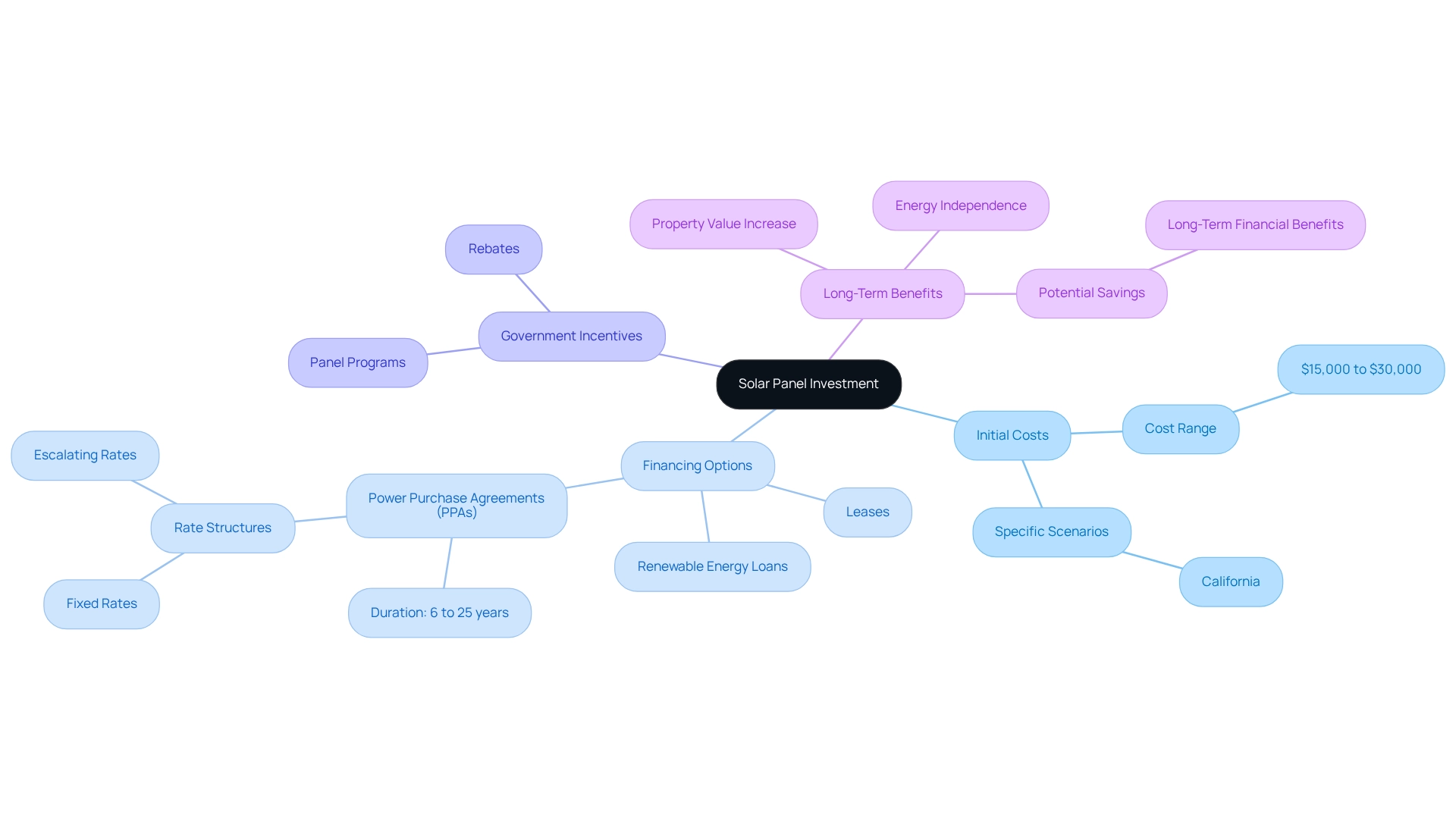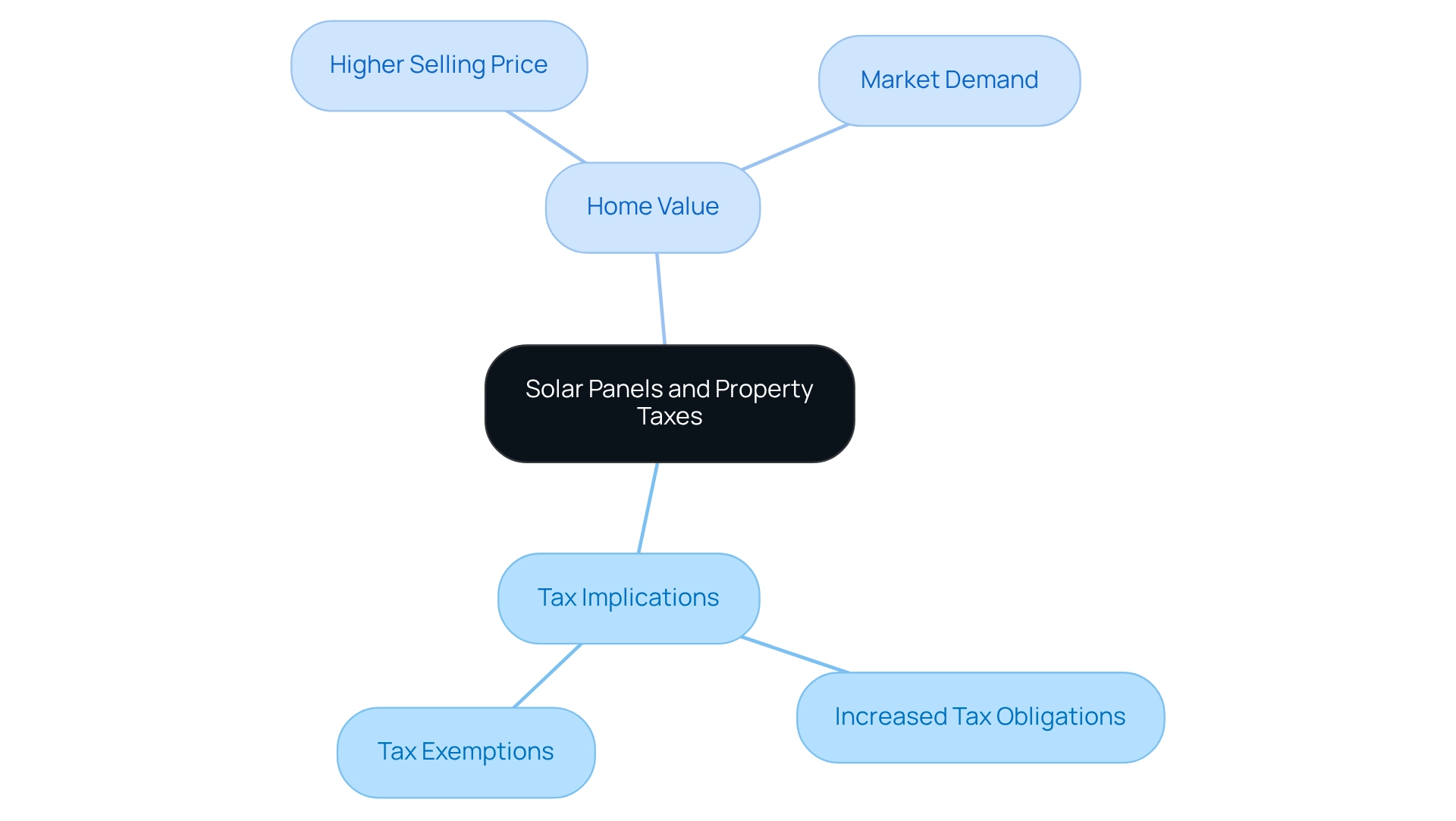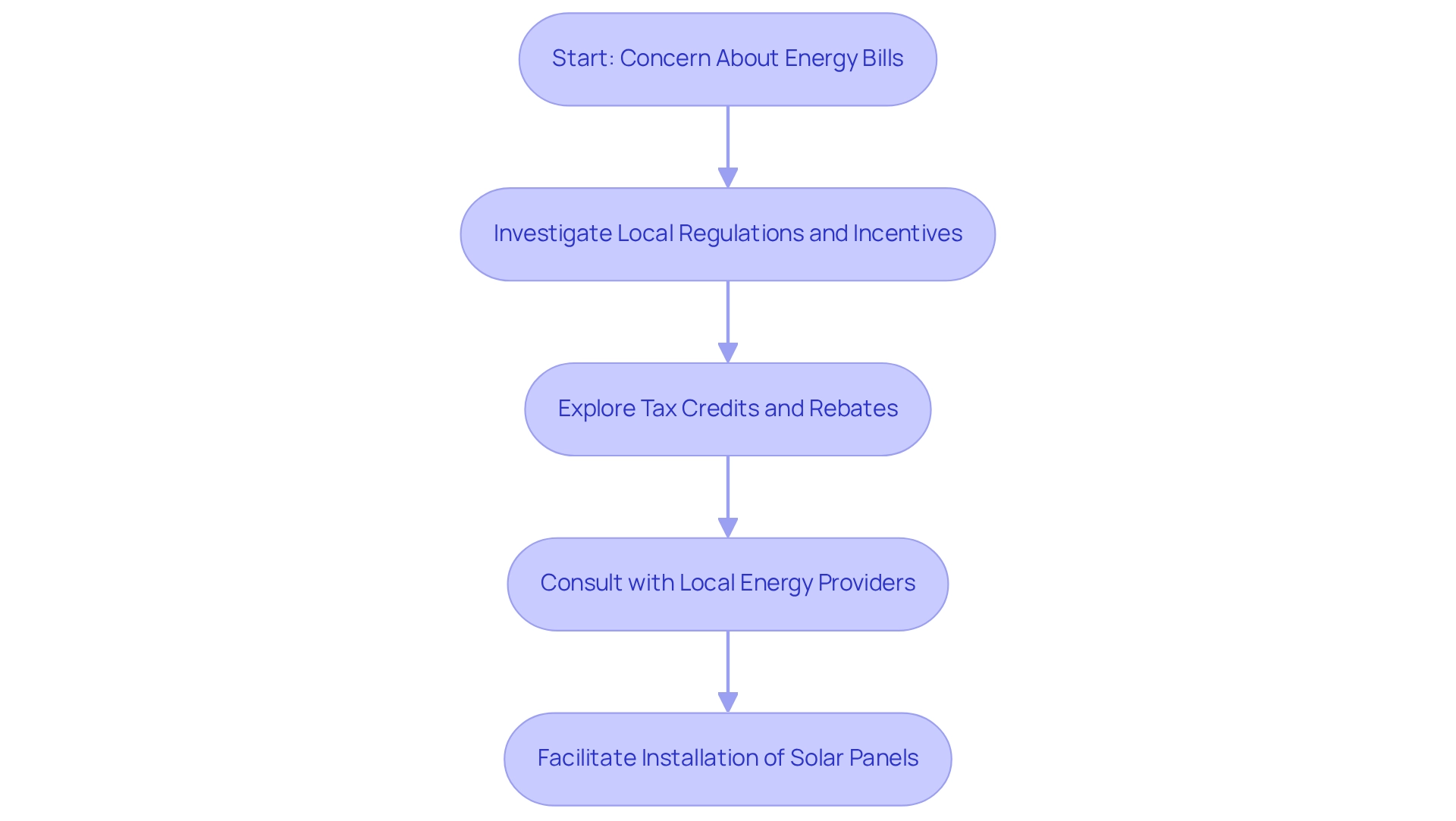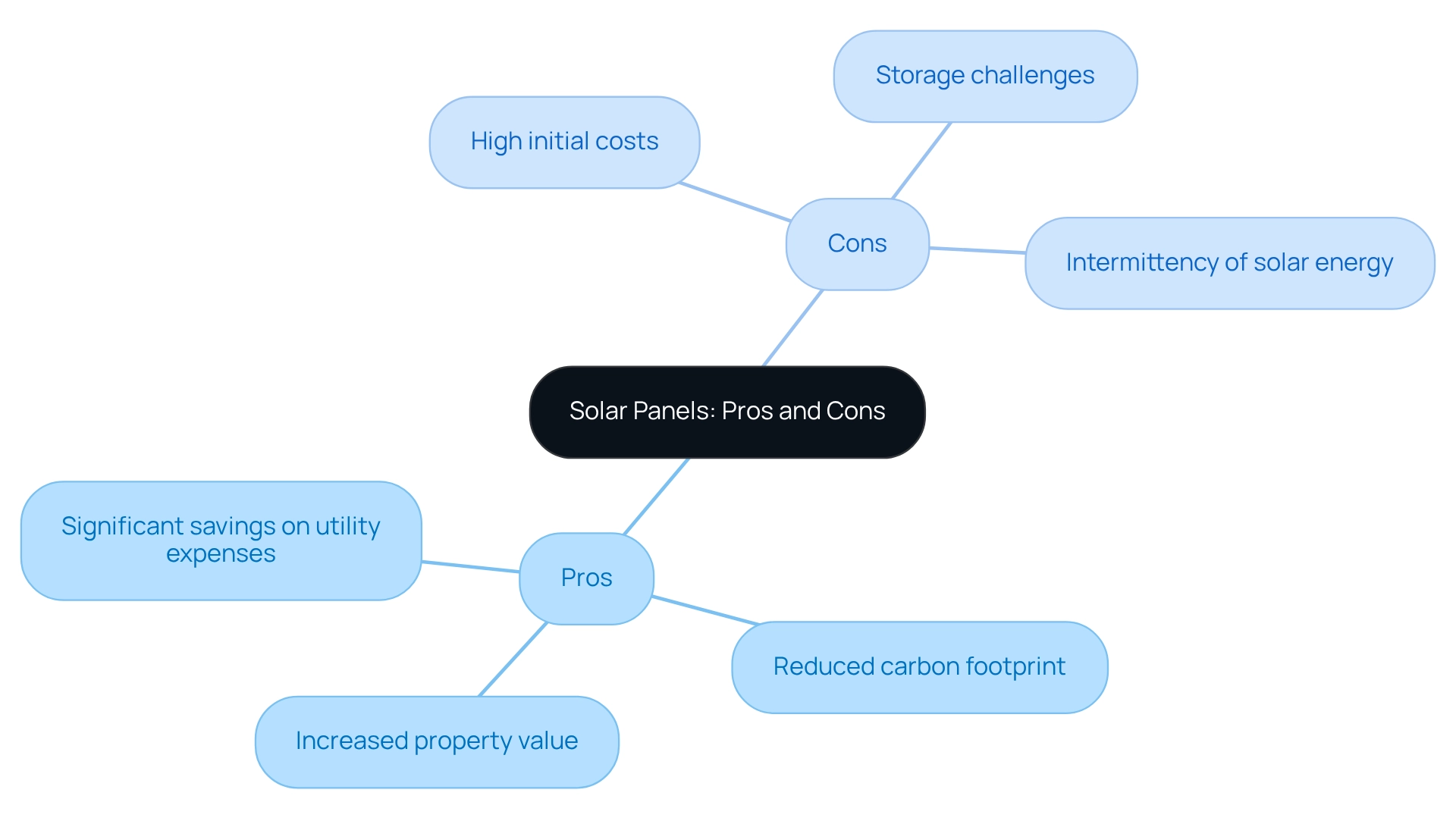Overview
The article titled “10 Home Solar Panels Pros, Cons, and Hidden Costs Explained” seeks to compassionately address the concerns of homeowners contemplating the installation of solar panels. It acknowledges the anxiety surrounding rising energy bills and emphasizes that while solar panels can provide substantial savings on utility expenses and contribute to a greener planet, they also present challenges such as high upfront costs, storage issues, and the intermittent nature of solar energy.
We understand that making the switch to solar energy can feel overwhelming, but the benefits can be transformative. By investing in solar panels, homeowners can not only reduce their energy costs but also gain greater independence from fluctuating energy prices. This journey towards energy independence is not just about savings; it’s about making a meaningful impact on the environment.
Ultimately, it’s important for homeowners to weigh these pros and cons thoughtfully. We encourage you to consider how solar energy aligns with your values and long-term goals. Together, we can explore the possibilities and find the best solutions tailored to your needs. If you have any questions or need guidance, please don’t hesitate to reach out. Your journey towards sustainable living is important, and we’re here to support you every step of the way.
Introduction
As homeowners, we often find ourselves grappling with rising energy bills and the quest for sustainable solutions. It’s common to feel overwhelmed by the choices available, but solar power stands out as a promising option, offering both environmental benefits and financial savings. Powercore Electric, a caring, family-owned leader in solar installations, has dedicated over three decades to helping residents like you harness the sun’s energy efficiently. With a focus on personalized service and innovative technology, the company not only helps reduce energy costs but also empowers you to achieve greater energy independence.
In this article, we will explore the multifaceted advantages of solar energy. Together, we’ll navigate the financial implications, understand local regulations, and address the challenges of energy storage and intermittency. By delving into both the benefits and potential drawbacks, you can make informed decisions about transitioning to solar power. Let’s work towards a more sustainable future, where you can feel confident in your energy choices and contribute positively to our planet.
Powercore Electric: Comprehensive Solar Solutions for Homeowners
At , a family-run company nestled in Roseville, California, we understand the concerns many homeowners face regarding rising energy bills. For over 30 years, we have been at the forefront of renewable power solutions, focusing on:
- Residential photovoltaic setups
- Power storage systems
- EV charging options
- Backup generators
Our commitment to utilizing cutting-edge technology empowers residents to effectively capture clean power, leading to reduced energy expenses and enhanced independence during outages.
In these challenging times of escalating power costs, we offer a solution that allows you to secure low rates through renewable sources. What truly sets Powercore Electric apart is our strong community focus and unwavering dedication to exceptional service. Our transparent and helpful in-house team is here to provide personalized assistance, ensuring that every client receives tailored solutions that meet their unique needs. With our extensive expertise in the industry and a clear service process, we position ourselves as a trusted partner for renewable solutions in California. Moreover, our innovative product range, including battery backups and , enables homeowners to store renewable resources for future use, fostering a more sustainable lifestyle.
As Ryan Serrano wisely notes, ‘With the right planning and resources, residents can enjoy the convenience of home charging while contributing to the broader movement towards sustainability.’ It’s also important for homeowners to understand the Federal Investment Tax Credit, which offers up to a 26% reduction on installation costs, making renewable solutions even more accessible and affordable, while considering the home solar panels pros cons and hidden costs associated with installation and maintenance. As more homeowners seek reliable and eco-friendly power options, Powercore Electric stands out as a reputable choice in the California renewable market. To ensure a smooth transition to renewable energy, we invite you to refer to our comprehensive step-by-step guide for setting up photovoltaic systems and to reach out for personalized support. Together, we can navigate this journey towards a sustainable future.
Environmental Impact: How Solar Panels Reduce Carbon Footprint
We understand that rising energy bills can be a source of stress for many homeowners. Solar panels offer a compassionate solution by significantly reducing carbon emissions, converting sunlight into electricity without releasing harmful pollutants. By harnessing the power of the sun, you can lessen your reliance on fossil fuels, which are major contributors to greenhouse gas emissions. This transition not only aids in the fight against climate change but also promotes cleaner air and a healthier environment for you and your loved ones.
Furthermore, consider the advantages of , which can heat water to temperatures as high as 400 degrees Fahrenheit. These systems provide substantial savings on utility bills while further reducing carbon emissions. Imagine not only cutting down on expenses but also enhancing your property’s value—making it more attractive to eco-conscious buyers. Research shows that widespread use of photovoltaic systems, including both solar panels and water heaters, can lead to significant reductions in overall carbon footprints, positioning them as vital components of sustainable living.
It’s common to feel overwhelmed by the options available, but rest assured that the financial rewards and rebates for photovoltaic installations make these systems even more appealing. Together, we can explore how these solutions not only benefit your wallet but also contribute to job creation and equitable access in the renewable sector. Let’s work towards a greener future, where energy independence is within reach and the environment thrives.
Cost Savings: Understanding the Financial Benefits of Solar Energy
We understand that rising electricity bills can be a significant concern for homeowners. Investing in photovoltaic systems offers considerable financial advantages, primarily through notable decreases in electricity expenses. By harnessing the power of sunlight, homeowners can enjoy reduced utility rates and shield themselves from the unpredictable nature of increasing service costs. In 2025, typical savings on electricity expenses from photovoltaic systems can reach up to 50%, depending on consumption and regional electricity costs. It’s remarkable to think that one hour of midday summer sunlight is equivalent to the yearly U.S. electricity requirement, showcasing the tremendous potential of sunlight to meet our power demands.
Moreover, many states provide incentives such as tax credits and rebates, which can significantly lower . As time goes on, these savings can surpass the initial expenditure, making photovoltaic panels a financially wise choice for homeowners. Additionally, photovoltaic systems often enhance property values, offering an extra layer of financial benefit.
With commercial installations averaging expenses between $1.80 and $3.50 per watt, and large-scale projects achieving even lower costs, the financial outlook for renewable power continues to improve, making it an increasingly appealing option for environmentally conscious homeowners. It’s essential to grasp the dimensions of residential photovoltaic panels, particularly under the 200% guideline, which allows residents to optimize their renewable power generation and savings.
As Al Gore poignantly stated, “You see that pale, blue dot? That’s us… it is your time to seize this issue, it is our time to rise again to secure our future.” This quote resonates deeply, emphasizing our moral obligation to invest in renewable energy and linking our individual financial choices to broader sustainability initiatives. However, it’s common to feel uncertain about the home solar panels pros cons and hidden costs involved; homeowners should also be aware that photovoltaic loans typically do not cover roof repair expenses, necessitating separate funding for those needs. Together, we can navigate these challenges and work towards a sustainable future.
High Initial Costs: Evaluating the Upfront Investment for Solar Panels
We understand that the initial expenses of photovoltaic panel installation can feel overwhelming, typically ranging from $15,000 to $30,000 depending on the system’s size and type. This significant investment often holds property owners back from embracing renewable energy. However, various financing options, such as , leases, and power purchase agreements (PPAs), can make these energy solutions more accessible.
In California, PPAs usually span six to twenty-five years and may feature fixed or increasing rates for electricity usage. This flexibility allows residents to manage their expenses effectively while enjoying the benefits of renewable energy.
Moreover, government panel programs offer incentives and rebates that can substantially reduce the total installation cost. These initiatives not only promote the adoption of renewable energy but also provide financial assistance, making photovoltaic energy more attainable for many homeowners. It’s essential for property owners to carefully evaluate these financing alternatives, as they can lead to significant long-term savings. For instance, over a 38-year period, a $34,000 loan could accrue an additional $29,000 due to increased payments, highlighting the importance of understanding loan terms and potential financial impacts. This consideration is especially crucial in California, where the renewable energy market is rapidly evolving, and homeowners must stay informed about local trends and funding options.
Furthermore, case studies indicate that older adults are particularly vulnerable to exploitative lending practices in renewable energy financing, often facing misrepresentation of loan conditions and tax incentives. This underscores the necessity for regulatory oversight and consumer protection initiatives within the renewable financing sector. Ultimately, while the initial costs of home solar panels installation in 2025 may seem daunting, the long-term financial benefits—including potential increases in property value, energy independence, and local incentives—make it a worthwhile investment for homeowners committed to sustainable solutions, especially when evaluating the home solar panels pros cons and hidden costs. To begin exploring funding options, we encourage property owners to seek guidance from local renewable solution providers or financial consultants specializing in sustainable resources. Together, we can navigate this journey towards a greener future.
Energy Storage Challenges: Managing Solar Energy for Home Use
We understand that managing power storage can be a significant concern for homeowners, especially when it comes to solar energy. Solar panels generate electricity during daylight hours, but the need for energy extends beyond that, including at night and on cloudy days. This is where storage systems, like batteries, become essential. They capture surplus power generated during peak sunlight hours, ensuring that you have energy when you need it most.
When considering energy storage options, it’s important to evaluate what works best for your unique situation. The best choices, such as lead-acid, lithium-ion, and flow systems, offer different capacities and efficiencies. However, the costs associated with these systems can be daunting, with average battery installation reaching around $12,390 in some areas. Ongoing maintenance is also a consideration to keep everything running smoothly.
As you plan your photovoltaic installations, reflect on your power usage trends and the capabilities of available storage options. Exciting advancements in technology are on the horizon, with improvements in efficiency and storage capabilities expected by 2025. Experts emphasize that while power storage systems can help alleviate the challenges of fluctuating sunlight generation, they require thoughtful planning to truly optimize their benefits.
The importance of battery capacity and power ratings cannot be overstated; they play a crucial role in managing your home’s energy needs sustainably. Case studies, such as those from Australia, highlight the necessity of adhering to rigorous installation standards for batteries. Following safety regulations not only ensures your safety but also impacts the placement and effectiveness of solar battery systems in your home.
Additionally, some users have reportedly earned over $2,000 in a year by utilizing Amber tariffs, which expose them to varying wholesale electricity costs. This showcases the potential financial benefits of . As property owners navigate these complexities, understanding the nuances of power storage options becomes vital for achieving energy independence and reliability.
Together, we can explore these options and find the best solutions for your energy needs. Let’s work towards a sustainable future, ensuring you feel empowered and supported every step of the way.
Intermittency Issues: Understanding Solar Energy Variability
We understand that energy bills can be a significant concern for homeowners, especially when considering the variability of solar power. Solar energy, while a promising renewable source, is inherently intermittent, with production fluctuating based on weather conditions and the time of day. For instance, photovoltaic panels generate limited electricity on overcast days or at night, which can pose challenges for those relying solely on renewable power. In 2024, sustainable power sources, including sunlight, represented almost one-quarter of total electricity production in the U.S. This statistic underscores our growing dependence on these technologies, highlighting the importance of managing the variability associated with sunlight generation.
To address these challenges, many property owners are choosing hybrid systems that combine photovoltaic power with other sources, such as wind or natural gas. This approach not only enhances reliability but also offers flexibility in power sourcing. Moreover, investing in power storage options, such as battery backups, allows homeowners to store surplus energy produced during sunny periods for use during unfavorable conditions, further mitigating the impact of intermittency. Key factors to consider when selecting a battery for photovoltaic systems include capacity, efficiency, lifespan, cost, and environmental benefits—elements that are crucial for optimizing the performance of renewable power systems.
It’s common to feel overwhelmed by the complexities of energy production, but expert insights can guide us through. Carolina D. Euan Campos, a Postdoctoral Research Fellow, shares, ‘Using our model we are able to simulate irradiance series that behave similar to the real data in mean and variability, and more accurate forecasts compared to its competitors.’ This insight sheds light on the limitations of traditional forecasting models, which often overlook the non-linear nature of sunlight production. By employing advanced statistical models, such as the multi-day threshold autoregressive (TAR) model, researchers have developed forecasts that more accurately reflect real-world conditions, distinguishing between clear-sky and non-clear-sky scenarios. This progress can help homeowners predict power generation more effectively and manage their energy needs with confidence.
As we look ahead, the impact of weather on sunlight-based production in 2025 is expected to remain significant, with output variations closely tied to changing weather patterns. Together, we can alleviate these intermittency issues by adopting and utilizing battery backups, which have proven to enhance reliability and efficiency during power outages and adverse weather conditions.
In summary, while photovoltaic production is subject to variability, homeowners can navigate these challenges effectively through hybrid systems and storage solutions. By understanding the effects of sunlight variability and taking proactive steps, we can ensure a steady and dependable power supply for our homes.
Property Tax Implications: How Solar Panels Affect Home Value
We understand that as a homeowner, you may be concerned about how could impact your property taxes. In many states, these energy installations are considered enhancements to your property, which can affect your tax obligations. However, it’s encouraging to know that some states offer property tax exemptions for renewable energy installations, meaning you might not see an increase in your property taxes.
Moreover, homes equipped with photovoltaic systems often sell for a higher price than those without, as more buyers are seeking energy-efficient features. This shift in the market reflects a growing desire for energy independence and sustainability. It’s common to feel uncertain about these changes, but investigating local regulations can provide clarity on how photovoltaic systems might influence your property taxes and overall home value.
Together, we can navigate these considerations, ensuring that you make informed decisions that benefit both your finances and the environment. If you’re ready to explore the possibilities of solar energy, let’s work towards a brighter, more sustainable future for your home.
Lifespan Considerations: Evaluating the Durability of Solar Panels
We understand that managing energy bills can be a significant concern for homeowners. Most photovoltaic modules offer a lifespan of , with many producers providing warranties that guarantee performance for at least 25 years. While it’s common for photovoltaic systems to experience a gradual decline in efficiency—typically between 0.5% to 1% annually—investing in higher-quality units can lead to improved performance and longevity.
By comprehending how photovoltaic panels function, you can maximize their advantages. Routine upkeep is essential; it can prolong the lifespan of these systems, ensuring optimal power generation throughout their duration. Furthermore, selecting the best batteries for effective power storage is crucial. This choice enables you to harness your renewable resources, especially during periods of limited sunlight. Together, we can work towards a more sustainable and energy-independent future, providing you with the support and guidance needed to make the most of your investment.
Local Regulations and Incentives: Navigating Solar Energy Policies
We understand that rising energy bills can be a significant concern for homeowners in Stockton and throughout California. Local regulations and incentives are crucial in easing this burden and promoting the adoption of renewable energy solutions. States like California offer various tax credits, rebates, and financial incentives, including the California Solar Initiative and (ITC), to support the installation of photovoltaic panels. By exploring these options, homeowners can find meaningful ways to reduce their energy expenses and contribute to a sustainable future.
Navigating local zoning laws and permitting processes may seem daunting, but understanding these regulations is essential for a smooth installation. We encourage homeowners to actively investigate the available incentives in their region and consult with local energy providers, such as Powercore Electric, who can guide them through compliance and help maximize financial advantages.
Together, by following a step-by-step approach to navigate these regulations, property owners can facilitate the installation process and enhance the overall value of investing in renewable power. Let’s work towards a brighter, more sustainable future, where energy independence is within reach for everyone.
Pros and Cons Overview: Weighing the Benefits and Drawbacks of Solar Panels
As homeowners, we often find ourselves grappling with rising energy bills, and it’s natural to seek solutions that not only ease our financial burdens but also contribute to a healthier planet. When considering pros cons and hidden costs, it’s essential to weigh the advantages alongside the disadvantages. The benefits are compelling:
- Significant savings on utility expenses
- A reduced carbon footprint
- An increase in property value, especially with government programs available to help offset initial costs
Moreover, advancements in solar technology, such as Tesla home chargers and efficient batteries, are enhancing storage solutions, making renewable energy more accessible than ever.
We understand that maintaining these systems can feel daunting, but routine upkeep, including professional cleaning services for photovoltaic systems, can greatly improve both performance and lifespan. However, it’s important to acknowledge the home solar panels pros cons and hidden costs, including potential drawbacks such as:
- High initial costs
- Storage challenges
- The intermittency of solar energy
By exploring both sides of the equation—like the significance of proper solar panel sizing under the 200% rule and insights from case studies that illustrate real-world benefits—homeowners can make informed choices about whether solar energy aligns with their needs.
Together, we can navigate these considerations, ensuring that your journey towards energy independence is supported every step of the way. Let’s work towards a sustainable future, one where your home not only meets your energy needs but also reflects your commitment to the environment.
Conclusion
We understand that the prospect of transitioning to solar energy might raise concerns about initial costs and energy bills. However, embracing solar energy offers homeowners a multitude of benefits, including substantial cost savings and a reduced carbon footprint. Powercore Electric is here to support you on this journey, bringing over three decades of experience in solar installations and a commitment to personalized service. With options like energy storage systems and electric vehicle charging solutions, you can enhance your energy independence while contributing to a healthier environment.
It’s common to feel apprehensive about the initial investment for solar panels, but the long-term financial advantages, paired with available incentives, make it a compelling choice. Understanding local regulations and financing opportunities is crucial for maximizing these benefits. As solar technology continues to advance, the potential for energy savings and increased property values only grows.
However, we recognize that challenges such as intermittency and energy storage issues can arise. By adopting hybrid systems and effective energy management strategies, you can navigate these complexities and ensure a reliable power supply. Ultimately, choosing to invest in solar energy aligns with your financial goals while contributing to a sustainable future. Together, we can make this thoughtful decision not just for you, but for the planet as well. Let’s work towards a brighter, greener tomorrow.







